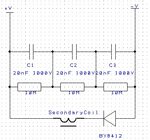cm_newbie
Newbie level 4

Hi,
I am new to hardware design. I had made some simple devices but I have now been asked to make 10kV power supply. It is supposed to be a high voltage, low current device 10kV and 3mA maximum. I am trying to adapt 5kV power supply I have got available. The 5kV uses two ferrite transformers to step up the voltage from 20V to around 2.5kV each. I tried to increase voltage on primary coil to 40V but it only gives ca. 4kV (i.e. 8kV total). So I decided to connect 4 ferrite transformers in series and power them from 20V on primary coil each. And after adjusting circuit on the secondary coils of ferrites I get... ca. 8kV maximum again... So my question is why does the second method not work? Is there anything I could adjust to achieve or would it be best to get new ferrites with more turns and just use two transformers?
Thanks
I am new to hardware design. I had made some simple devices but I have now been asked to make 10kV power supply. It is supposed to be a high voltage, low current device 10kV and 3mA maximum. I am trying to adapt 5kV power supply I have got available. The 5kV uses two ferrite transformers to step up the voltage from 20V to around 2.5kV each. I tried to increase voltage on primary coil to 40V but it only gives ca. 4kV (i.e. 8kV total). So I decided to connect 4 ferrite transformers in series and power them from 20V on primary coil each. And after adjusting circuit on the secondary coils of ferrites I get... ca. 8kV maximum again... So my question is why does the second method not work? Is there anything I could adjust to achieve or would it be best to get new ferrites with more turns and just use two transformers?
Thanks





